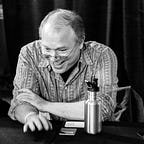The Blackest Black for Science and Art
An obsession with finding a shade darker than our language can effectively describe
How to make black printing ink: …An hundred pounds of nut or linseed oil being brought by boiling to the consistence of a syrup, and purified by throwing into it two pounds of coarse bread, and about a dozen onions: Then thirty or thirty five pounds of turpentine, are boiled apart, till such time as they find, upon its cooling on paper that it breaks clean like glass without pulverizing…
— A Concise History of Printing (1774), p. 149
I put on the cloak…the hue fuligin, which is darker than black, admirably erases all folds, bunchings and gatherings so far as the eye is concerned, showing only a featureless dark.
— The Shadow of the Torturer (1980) by Gene Wolfe
There’s an obsession with how one can cover a medium with a black that is so intense it seems blacker than black. That seems an oxymoron: If black is our reference point, how can we see a black that is blacker than black? But you know intuitively this is true, because you’ve seen variations in adjacent blacks.
Something coated in black absorbs light across a broad spectrum so thoroughly that few photons vibrating at the right wavelengths to show color reflect off it.
Our eyes are designed to perceive black better than color. The retina comprises cells that looks like rods and cones, and which interpret light differently. The rods register monochromatic light (technically recognizing colors peaking near green), while cones receive light across the visible spectrum, with cells specialized to respond to peaks at red, green, and yellow wavelengths.
We have roughly 100 million rod cells compared to 6 million cone cells, and the rod cells are more sensitive as well. A very small number of photons need to fall onto a rod to register light. That combination of quantity and sensitivity lets us differentiate shades of gray in shockingly fine gradations and to see at night. (This is an effective trait evolutionarily for hunting and survival.)
But it’s also why we can perceive differences among a range of blacks placed side by side, while we might call them all black when…
